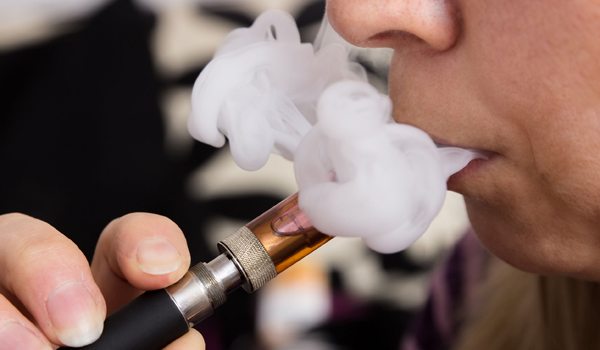It’s common now to spot someone in public holding an electronic cigarette and “vaping,” or inhaling and exhaling a cloud of flavored vapor.
Oxford Dictionaries even picked up on the trend, naming “vape” the 2014 word of the year, signifying the beginning phase of replacing an age-old habit of smoking tobacco. But is vaping a trend that is better or worse than smoking tobacco when it comes to the user’s health?
At Arizona’s first e-cigarette and vapor expo in October, people — some young, some older — walked through the maze of booths looking and testing out handheld devices that are commonly used to replace smoking a tobacco cigarette.
“What now I believe people are being turned on to, why the gums and patches don’t work, is because there’s a whole level that is missing in people’s lives and that’s the social aspect (of smoking),” said Michael Guasch, president of Molecule Labs, which manufacturers e-liquids. “So when you can sit around and vape with someone and enjoy good conversation in a much more healthy manner, you’re not destroying your clothes and the environment you’re in.”
The two most common styles of electronic cigarettes, or e-cigs, are the traditional disposable cartridge style, which looks more like a tobacco cigarette; and the refillable tank-style“vaping device”, which can look like a pen, is reusable, rechargeable and more commonly used today, according to Guasch.
“An e-cigarette is comprised of a battery, an atomizer, which has a wick with a heating element and then that produces the vapor upon the draw,” said Stephen Beckers, owner of TKO Vapor.
Inside the debate
While the types of liquid flavoring and the catchy names are enticing, it’s what is inside of these e-liquids that counts for consumers.
“E-cigarettes typically contain three main ingredients: nicotine, a flavoring of some kind and propylene glycol — a syrupy synthetic liquid added to food, cosmetics, and certain medicines to absorb water and help them stay moist,” said Frank LoVecchio, D.O., a medical toxicologist at the Banner Good Samaritan Poison and Drug Information Referral Center.
The ingredients inside of the e-liquids are not only responsible for satisfying cravings, but also for creating nationwide debate on just how safe and healthy they are for consumers.
“Various studies suggest the vapors from e-cigarettes contain several cancer-causing substances, as well as incredibly tiny particles of tin, chromium, nickel and other heavy metals, which, in large enough concentrations, can damage the lungs,” LoVecchio said. “These particles likely fleck off the solder joints or metal coil in the devices when heated. Because they are so small, the tiniest bits of metal, known as nanoparticles, can travel deep into the lungs. There, they could exacerbate asthma, bronchitis — an inflammation of the tubes that carry air to and from the lungs — and emphysema — a disease in which the lungs’ many air sacs are destroyed, leaving patients short of breath. So far, there are not enough data to say with certainty whether e-cigs worsen these disorders.”
Since the e-cig industry is still young, the lack of research and studies performed to determine whether e-cigs are a healthier option than using traditional tobacco cigarettes leaves the question unanswered. While tobacco isn’t used in e-liquids, nicotine is and can be addictive.
“Using e-cigarettes avoids the harms of smoke, but the nicotine they contain is addictive and has many known harmful effects,” said Rodney D. Altman, M.D., of Abrazo Health. “It is possible that the aerosol could somehow enhance the delivery of nicotine into the blood or tissues which could outweigh the benefit of avoiding smoke.”
“The primary established danger of nicotine is that the stimulant is highly addictive, although emerging science also links it to an impaired immune system,” LoVecchio said.
The risks for kids
Altman said health concerns with nicotine are not just for vapers themselves, but for children if proper caution isn’t taken when using e-cigs.
“Young children are typically poisoned from traditional cigarettes when they eat them,” Altman said. “Poisoning related to e-cigarettes involves the liquid containing nicotine used in the devices and can occur in three ways: by ingestion, inhalation or absorption through the skin or eyes. Poisonings for electronic cigarettes are increasing dramatically. About half of these occur in children under 5 and 6 years of age.”
There is, however, an option for no nicotine in e-liquids, with typical levels ranging from 0-24 mg of nicotine. Selling flavored liquid with no nicotine or lowering a vaper’s nicotine levels throughout a period of time are options provided by some e-cig shops and manufacturers.
“It’s right to have a wide variety of different levels,” Gusich said. “Let the customer pick whatever works best for them. We don’t want them to be at a higher dose of nicotine than what they were normally smoking in regular cigarettes. This is their chance to be able to choose what they want and make it easier for them to adjust to this lifestyle.”
However, even if there is no nicotine present in the e-liquid cartridge someone is inhaling, there is still a potential for health risks with propylene glycol.
“Propylene glycol, for example, is usually eaten (in cupcakes, soft drinks and salad dressings) or slathered onto the body (in soaps, shampoos and antiperspirants) — not breathed into the lungs,” LoVecchio said, “so this needs to be studied. For example flour—can damage the lungs when inhaled.”
Terminology confusion, inaccurate labeling and just who exactly is making the e-liquids also present areas for health concerns.
Since the e-cigs industry is still relatively new and lacks standardizations and regulations by the FDA, potential risks arise with inexperienced manufacturers — or even consumers — handle the nicotine.
“I think the risks from e-cigs come from lack of standardization and not knowing what some companies are putting in their liquids,” Beckers said
Booming business
E-cigs have become so popular in the short eight years they’ve been available, the industry surpassed $1 billion in sales in the United States in 2013.
“There’s so many different companies trying to get into it, it’s almost like a gold rush,” said Geoff Habicht , chief operating officer of Smoking Vapor. “You have these vape shops opening up on every corner and there’s several thousand in Arizona. The market this year will be about $4 billion and is expected to be $7 billion or $8 billion next year.”.
The e-cig industry may seem like a great place for entrepreneurs to get rich fast, but it won’t be for long. With the impending FDA regulations on the selling and manufacturing of e-liquids, a lot of the small shops could disappear because of the inability to meet strict guidelines.
“Like any business, there are a lot of businesses that fail,” Habicht said. “We’re going to reach a point of saturation where you can’t have a vape shop on every single corner.”
When it’s all said and done, there will be more than two sides to this story. The e-cig industry advertises itself as healthier alternatives to smoking tobacco cigarettes. Some lawmakers and medical professionals are pointing out that there is no scientific evidence to back up these claims. Consumers, especially Millennials, are more focused on the social aspect. Regardless of who is right or wrong, consumers need to be educated on what they’re putting in their bodies.
“This is a product that should not be advertised at all to kids,” Guasch said. “They should never be a product that makes you look cool.”




